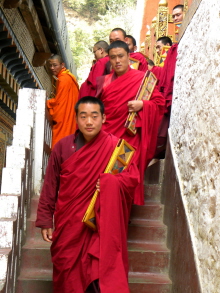A country unblemished, totally pristine. Only open to outsiders since the 1970s and always limiting the number of visitors, Bhutan offers a trip to a world you won’t find anywhere else. How do you go about planning a trip there? Below, Indian Subcontinent travel expert, Susan Geringer, answers all of the questions you might have. Contact us to make your trip become a reality.
FarewellTravels: Bhutan is often referred to as “The Last Shangri-La,” which certainly makes it sound inviting. What is it about the country that has earned it such a flattering name?
Susan Geringer: Its isolation, its peacefulness, its beauty…really many things. Bhutan is not polluted and it’s not overcrowded. Since it wasn’t open to the world until the 70s, it has not had as much Western influence as many other Eastern countries have had. It is not built up at all and most of the country is rural.
FarewellTravels: We’ve heard that Bhutan is great for hiking, and that it even has some mountains that have never been climbed. What kind of hikes are there for recreational hikers, who aren’t all that experienced but just want to get out there? 
Susan Geringer: The Tiger’s Nest Monastery Hike is the country’s most famous one and is ideal for a recreational hiker. Of course, you have to be in fairly good condition, as the altitude is higher and it’s all uphill. The 17th-century monastery (pictured right) is 3,000 feet up on a sheer cliff overlooking the Paro Valley. You can hike all the way up, stopping for tea halfway, or opt to turn around at that point (it’s about an hour and a half to the tea house; an hour more to the monastery itself). You can also ride donkeys up.
FarewellTravels: What kind of cultural attractions are there?
Susan Geringer: Visiting monasteries is really the main cultural pursuit in Bhutan. You can go see how the Buddhist monks live and hear them pray. Guides are very helpful in providing insights and information on what is  the purest form of Buddhism they practice. There are other cultural attractions as well. For example, in Thimphu (the capital and country’s largest city), you can visit the School of Arts & Crafts, the Textile Museum and National Library. Each section of Bhutan also has its own Dzong, which is a Medieval fortress. the purest form of Buddhism they practice. There are other cultural attractions as well. For example, in Thimphu (the capital and country’s largest city), you can visit the School of Arts & Crafts, the Textile Museum and National Library. Each section of Bhutan also has its own Dzong, which is a Medieval fortress.
FarewellTravels: We understand that visitors to Bhutan are not allowed to tour on their own, as they can in most countries. Can you explain this?
Susan Geringer: Once you decide to visit Bhutan, you work with a travel specialist who in turn, works with a Bhutan tour operator. You are given a car, guide and driver for the duration of your stay and a specific itinerary based on your interests. There is a set price of approximately $200 a day per person (depending upon season and how many people are traveling together), which includes everything (car, driver, guide, standard hotel accommodations and all meals). This is set by the government. There are some luxury hotels at additional costs.
FarewellTravels: When should we go, how long should we stay and where do we fly into?
Susan Geringer: Best to go  in the spring (March, April and May when the flowers are blooming) or fall (September, October, November when the skies are clear and the views of the Himalayas are great). Most of the festivals occur in the spring and autumn. Winter is okay too, but there is snow (which can be beautiful). So anytime between October and April. The rains come in the summer months. in the spring (March, April and May when the flowers are blooming) or fall (September, October, November when the skies are clear and the views of the Himalayas are great). Most of the festivals occur in the spring and autumn. Winter is okay too, but there is snow (which can be beautiful). So anytime between October and April. The rains come in the summer months.
Nine nights is an excellent amount of time to spend visiting the country. You fly into Paro, from Delhi, Kolkata (Calcutta), Kathmandu, Bangkok or Dhaka, Bangladesh.
FarewellTravels: Would you recommend combining a visit to Bhutan with any other destination?
Susan Geringer: Absolutely. I would say combine it with Nepal, India or Thailand.
Photos: From top to bottom, the Tiger's Nest Monastery; Buddhist Monks; a Bhutanese family hiking. All photos by Susan Geringer.
|

